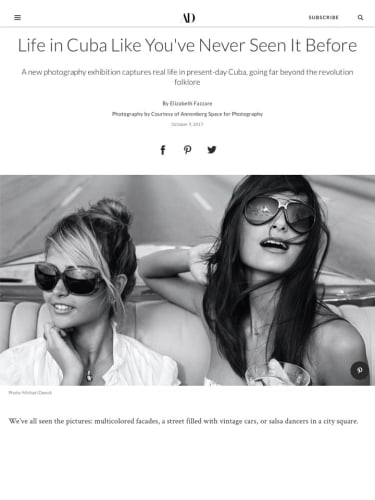Life in Cuba Like You've Never Seen It Before
Architectural Digest
10/09/2017
Back
By Elizabeth Fazzare
A new photography exhibition captures real life in present-day Cuba, going far beyond the revolution folklore
We’ve all seen the pictures: multicolored facades, a street filled with vintage cars, or salsa dancers in a city square. “There is a big focus on the 1950s because this is the peak sexiness of Cuba, the time of revolution,” said Iliana Cepero, the curator of a new photography exhibition, “Cuba Is,” at the Annenberg Space for Photography in Los Angeles. “However, this is a Cuba that people don’t talk about anymore in Cuba. We wanted to show an American audience what Cuba is today, in the present.” Part of the Getty-led “Pacific Standard Time: LA/LA” series of exhibitions showing work by Latin American artists in Southern California, the extensive show (which runs through March 4, 2018) features more than 120 photographs, by both American and Cuban diaspora photographers. Cepero's curation guaranteed that none would be found in a typical guidebook, giving an American audience a view of the nation free of travel-image folklore while addressing tough issues, from racism to class discrepancies. From “los frikis” ravers to the country’s badly behaved creative class (the ultrarich children of Cuba’s military elite), the show begins and ends with images of youth, leaving a visitor with thoughts of the nation's future, not its past. “Cuba is many things; it’s beyond revolution," said Cepero. "Cubans want to be part of the world’s global network. They want the same opportunities as the rest of the world.”
Michael Christopher Brown, 2015
Helen and friends wait for their $1 cheese pizzas in the Playa neighborhood of Havana; from the series "Paradiso." Cepero's decision to include both American and emerging Cuban photographers was a question of access and, sometimes, safety. "There are certain aspects of society that Cuban photographers don't have access to," she revealed. "Michael Christopher Brown lives with his subjects for weeks to capture them. Cuban photographers don't have that kind of luxury of time."
Michael Dweck, 2009
Giselle and Rachel cruising down the Malecón, Havana, from the series "Habana Libre." American photographer "Michael Dweck has access to the privileged children of Cuba's military elite;" however, Cepero notes that it "wouldn't be safe" for a Cuban photographer to pursue this kind of subject. The elites' lives are a "hidden truth," and a Cuban layperson would be considered to know too much.
Hermes Mallea and Adrian Fernández, 2016
The garden façade of the house constructed in 1930 for Estanislao de Valle in the Venetian Gothic style, Havana.
Tria Giovan, 1993
Beauty salon in the Vedado neighborhood, Havana.
Leysis Quesada Vera, 2014
Mia, Avril, and Denise in Havana. In 2014, when former President Obama's so-called "Cuban thaw" lessened travel restrictions between the United States and Cuba in 2014, the latter sprung up as an adventurers' hot spot for Americans. "After that, people got curious about the future of Cuba," said Cepero. "So in this show, we wanted to avoid the folkloric images at all costs."
Elliott Erwitt, 2015
Santería celebration in the Regla neighborhood of Havana.
Luis Gispert, 2002
Untitled (Dinner Girls)
Raul Cañibano, 2006
Man with crocodile in Ciénaga de Zapata.
René Peña, 2009
Untitled, from the series "White Things."